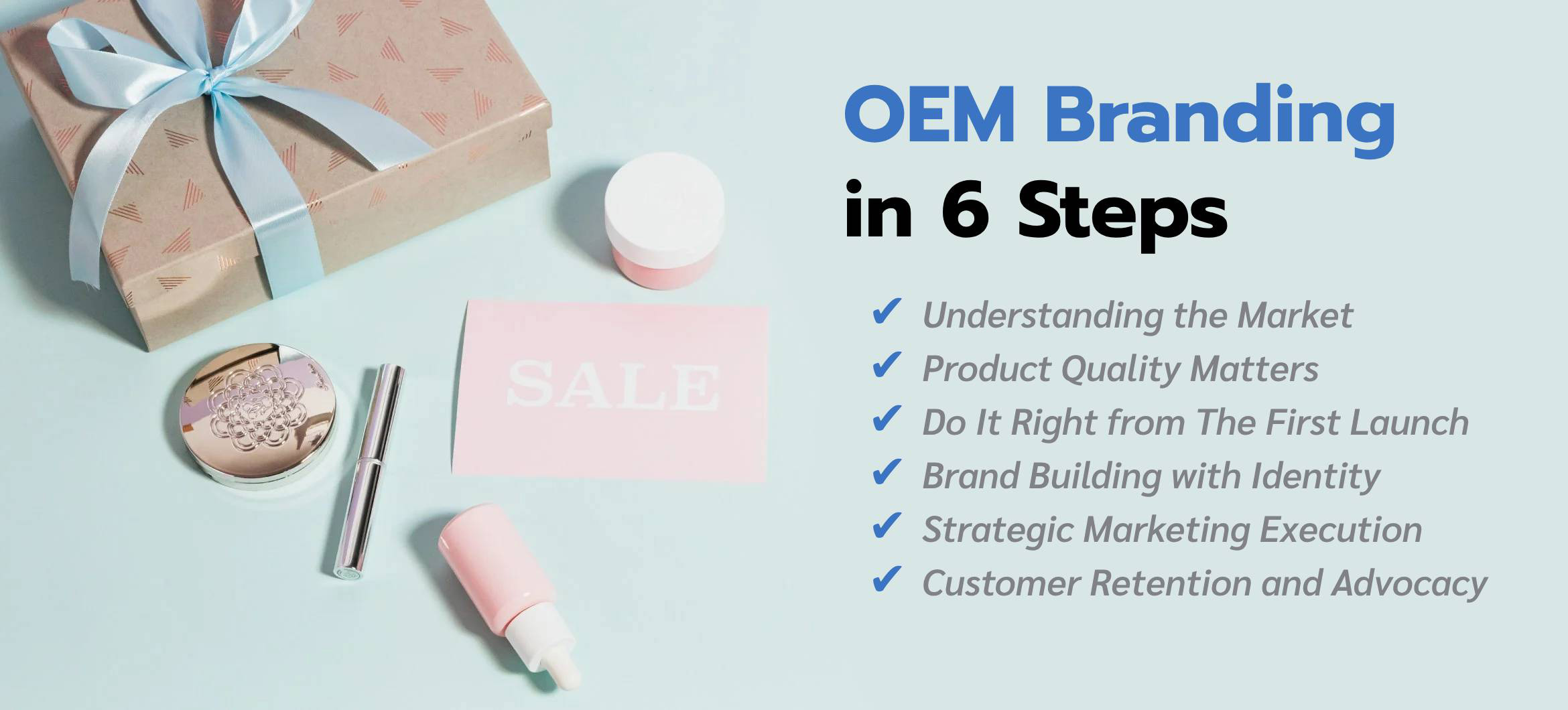
Considering starting your own cosmetic brand? This overview guides you through key considerations for success.
While not exhaustive, it lays a crucial foundation. Each point, rich with details, prompts deeper exploration for your future endeavors.
- Understanding the Market Landscape: Understand your audience, industry, and competition. Strategize your market entry and competitive edge.
- Product Quality Matters: Develop high-quality products from the start. Minimize future challenges in sales and marketing.
- Do It Right from The First Launch: Ensure legal compliance from the beginning. Establish a sustainable market presence.
- Brand Building with Identity: Initiate brand development with a strong identity. Foster sustainable product sales and reduce marketing costs.
- Strategic Marketing Execution: Align marketing efforts with your planned brand model. Enhance brand recall for your target audience.
- Customer Retention and Advocacy: Cultivate repeat customers and turn them into advocates. Consistently deliver on your brand promise and improve services.
List of contents
Embarking on the journey of creating your own cosmetics brand is a dream for many. However, navigating the complexities of product branding and ensuring successful sales can be a daunting challenge. The key lies in understanding fundamental guidelines that demystify the process of production, sales, and brand creation. For aspiring cosmetic entrepreneurs, the initial step is crucial.
1. Understanding the Market Landscape
Do the market research! Embarking on your cosmetics business journey starts with understanding the market intricacies. Know your target audience and gain insights into the competitive landscape. Evaluate not only direct competitors but also indirect competitors, considering factors like competitive intensity, advantages, and disadvantages. the strengths and weaknesses of competitors to strategically position yourself in the market.
2.Product Quality Matters
In the competitive world of cosmetics, the mantra “A good product sells itself” holds true. While effective marketing is essential, the quality of your product plays a pivotal role. Consider this: when you use high-quality products and consistently have positive experiences, you become more likely to make repeat purchases and recommend them to others.
Despite robust marketing efforts, if the product lacks quality, customers may shift allegiance. Prioritize developing products of genuine excellence, ones you love and believe in, before venturing into sales.
3. Do It Right from The First Launch
Ensuring your business’s ethical, legal, and right conduct from the start acts as the primary defense, shielding your brand and products from potential pitfalls down the road. Post-product development, before initiating brand building or promotion, the next crucial step is securing a cosmetic license, commonly referred to as “applying for the FDA.”
Furthermore, familiarize yourself with the legal framework relevant to your product’s nature. Having a clear understanding of do’s and don’ts prior to commencing operations helps prevent future regrets. As a business owner, staying well-informed and navigating potential challenges conscientiously ensures a smoother journey to success.
4. Brand Building with Identity
In a world where everyone has the same 24 hours, creating a brand that stands out and remains memorable is crucial. Customers, like everyone else, don’t want to invest their time in something forgettable. Enter brand identity, encompassing unique product characteristics such as brand name, slogan, logo, colors, content tone, and brand story. This extends to designing all promotional materials, from websites to business cards and banners, ensuring a distinctive presence in the market.
Investing time in crafting a robust brand identity not only aids in brand recall but also streamlines the sales process in the long run. Making your brand memorable ensures a lasting impression on your customers, fostering a connection that goes beyond the transactional.
5. Strategic Marketing Execution
With the product fully developed and a carefully crafted brand strategy in place, the next step is strategic marketing execution. This involves leveraging diverse communication channels, including online avenues like website creation and social media promotion, as well as offline marketing efforts.
Before launching any public marketing campaigns, a critical prerequisite is ensuring alignment with your thoughtfully designed brand identity. This strategic checkpoint ensures that every promotional initiative resonates seamlessly with the brand you’ve meticulously cultivated.
6. Customer Retention and Advocacy
- Keep Promises for Lasting Trust: Uphold the fundamental principle of any brand—delivering consistent product value. Reliability is paramount. Customers expect the same positive results they experienced initially with each purchase. A single instance of unfulfilled promises may deter their return, emphasizing the importance of steadfast commitment.
- Holistic Customer Service Approach: Extend customer service beyond the point of sale, fostering continuous engagement. Creating a sense of connection throughout the customer journey strengthens their affinity with your brand.
- Cultivate a Loyal Community: Transition customers from users to advocates by nurturing brand addiction. Encourage them to share positive stories about your products. Building a community of brand believers becomes a powerful sales channel (owned media). Leveraging this channel for promotions and marketing campaigns is highly efficient, as it taps into a community that already trusts and believes in your product.
7. Conclusion
Aspects to Consider | Description | Reasons Why You Should Do It |
|---|---|---|
Research, get to know the market | Understand industry, market, and target audience | To enter the market correctly, aligned with target needs, and know your position in the market |
Develop products that meet needs | Ensure high-quality products from the beginning | “Quality products” are the foundation for sustainable sales and brand strengthening |
Ensure a flawless start | Adhere to laws and values, apply for FDA if cosmetic | Prevent legal issues, ensure uninterrupted sales, and achieve sustainable success |
Start building a brand | Develop brand identity and design recognizable elements | Enhance brand recall, making products memorable for consumers |
Do marketing in line with the brand | Promote products through various channels consistently | Strengthen brand presence, efficient marketing when aligned with established brand |
Make customers buy again and advocate | Consistently keep promises, provide excellent products | Loyal customers become powerful advocates, driving sales more effectively than traditional means |


